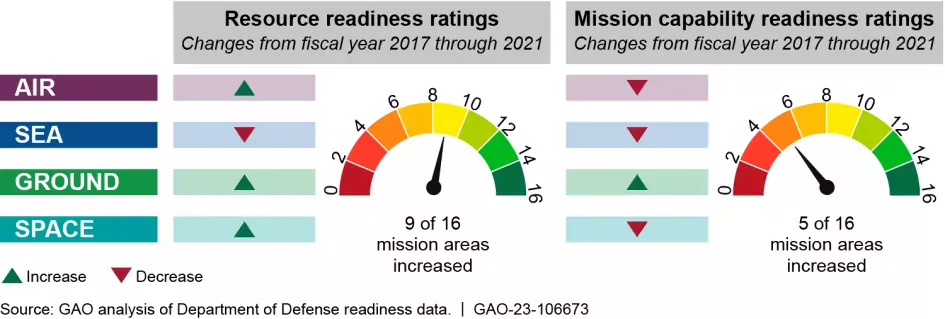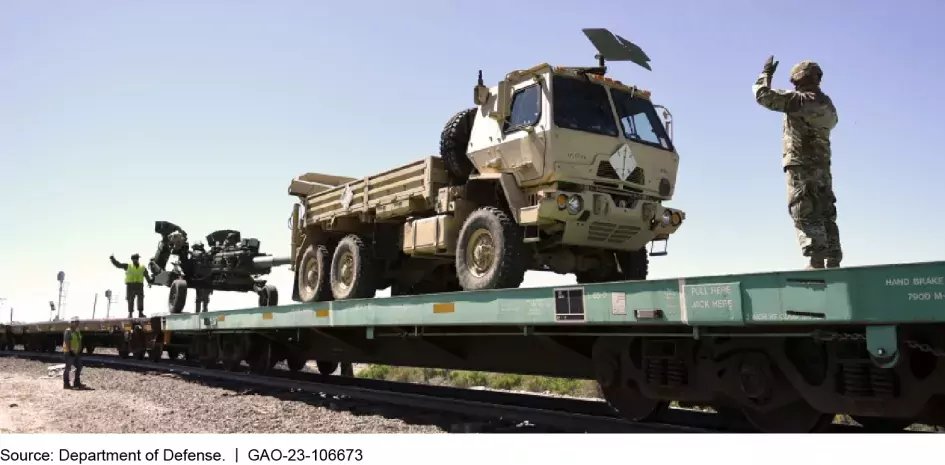U.S. Military Working to Rebuild Readiness and Modernize
For decades, the U.S. has enjoyed an unchallenged military advantage. It could deploy forces when it wanted, assemble them where it wanted, and operate how it wanted. But nearly two decades of conflict in Iraq and Afghanistan, and the capabilities of potential adversaries—notably China and Russia—have put new pressure on U.S. forces. The U.S. military is working to rebuild readiness while also modernizing its forces to prepare for future threats.
Yesterday, GAO’s Diana Maurer, an expert on military mission readiness, testified before Congress about the challenges the Department of Defense faces in rebuilding, restoring, and modernizing the military. Today’s WatchBlog post looks at this testimony and our work on military readiness. To watch the full congressional hearing on military readiness, click here.
Mixed readiness changes over the past 5 years (FY 2017 to 2021)
When we’re looking for readiness, we want to see that a military unit has the resources and capabilities to successfully carry out its mission. For example, if an air unit has what it needs to successfully refuel a bomber in flight, it can be considered ready. If a cyber-unit has the technology and people it needs to defend against a cyberattack, it’s ready.
Over the past 5 years (fiscal years 2017-2021), our work has shown mixed changes in overall readiness, while we’ve identified a wide range of persistent challenges in each of the domains where the military operates: in the air, in the sea, on the ground, and in space.
Change in Resource and Mission Readiness from FY 2017-2021
Image

Air. In November 2022, we reported that while the DOD spends tens of billions of dollars annually to sustain its aircraft fleets (fighters, helicopters, bombers and more), 47 of the 49 aircraft we reviewed didn’t meet goals for their “mission capable rates”—the percentage of time when the aircraft can fly and perform at least one mission. Most of these aircraft were more than 10 percentage points below their goal rates. Officials told us they faced readiness challenges such as aging aircraft, maintenance, and issues with getting parts and supplies.
Sea. In January, we reported that an estimated $1.8 billion in ship maintenance backlogs had contributed to a decline in readiness. We reviewed 10 surface ship classes—including aircraft carriers, destroyers, cruisers, and littoral combat ships—and found that they faced persistent and worsening challenges that decreased the number of hours ships were available for operations or training. These challenges included an increase in the number of working ship parts removed and used elsewhere due to parts shortages, an increase in events that impaired a ship’s ability to do its job, and increased maintenance delays due in part to the condition of Navy shipyards.
Image

Ground. We have seen some increases in ground readiness during the past 5 years (FY 2017-2021). But there are areas with shortfalls that could be improved. For example, Army officials have stated that to support operations, about 67% of Army unit equipment is moved by rail from its fort or base of origin to a shipping port. In 2003, nearly 1 million tons of unit equipment was moved by rail in support of Operation Iraqi Freedom. However, the Army cut its rail operating force by 70% after a 2015 analysis concluded that it didn’t need its own crews and could rely on civilians. Since then, the remaining crews have been in high demand, and Army officials said it’s unclear what would happen in a large mobilization.
Image

Space. We’ve reported on a variety of military challenges in space. These include taking steps that would ensure the U.S. is prepared to maintain freedom of operations in space. For example, the U.S. wants to ensure its satellites are protected from disruption (like an adversary jamming satellite communication signals or using lasers to “blind” satellites taking images of the Earth). But to do this, DOD needs to assess its readiness to conduct missions in the midst of potential adversary interference. Additionally, while DOD has developed a strategy for future space operations, it must also establish metrics for measuring progress toward its goals.
What needs to happen next?
DOD’s efforts to rebuild readiness come at a challenging time and require the department to make difficult decisions regarding how best to address present demands while preparing for the future. An important aspect of this, across all of the services, is determining an appropriate balance between maintaining and upgrading weapon systems currently in use and acquiring new platforms able to overcome rapidly advancing future threats.
We have dozens of recommendations to help DOD address the challenges ahead. To learn more about our work on military readiness, visit our special topic page.
- Comments on GAO’s WatchBlog? Contact blog@gao.gov.





